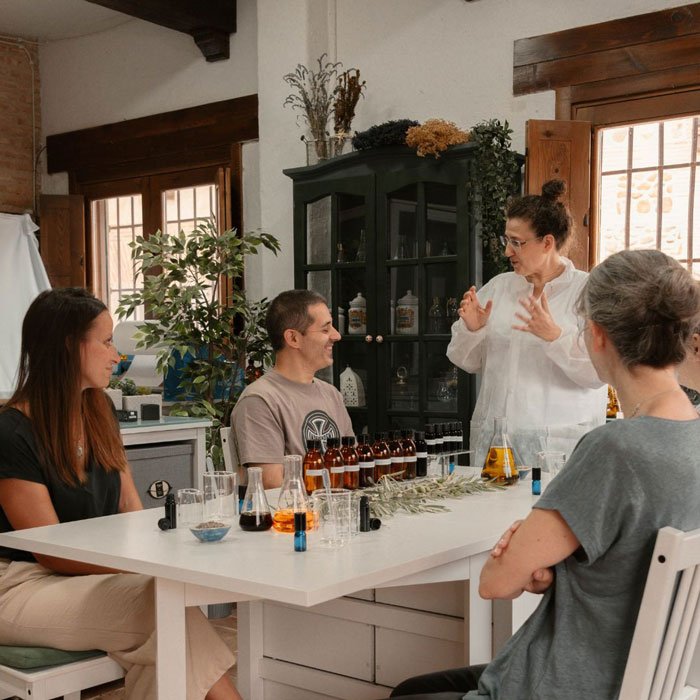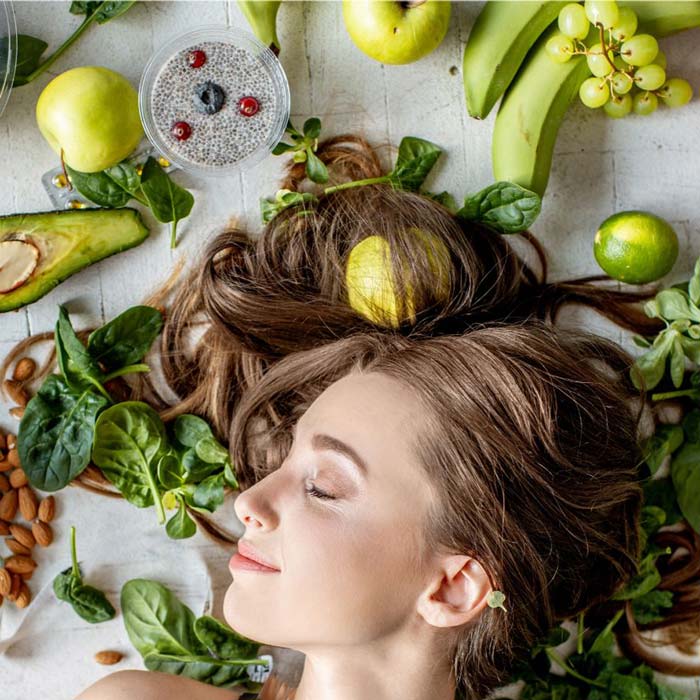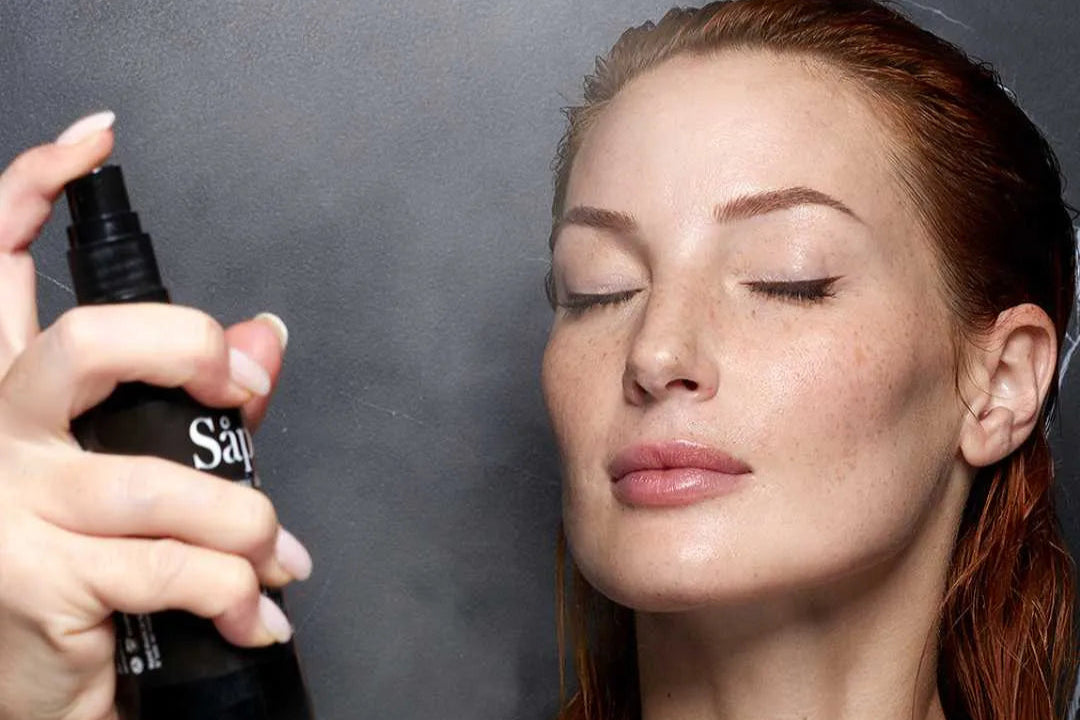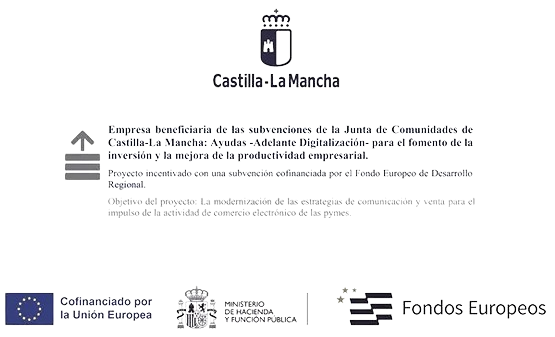According to a report by Claight Corp., the perfume market was valued at approximately USD 48.42 billion in 2023. The report forecasts growth of 5.5% in the coming years, reaching a value of USD 78.40 billion by 2032. This represents a significant opportunity for natural perfumes.
Composition of a conventional perfume: Beyond synthetic molecules
Conventional perfumes are primarily composed of a combination of synthetic molecules, alcohol, and water. In addition to these artificial molecules, conventional perfumes may contain a variety of ingredients, such as preservatives, colorants, and stabilizers, which serve to enhance the longevity and stability of the fragrance.
Let's look at some of the key ingredients in the formulation of a conventional perfume:
- Solvents: A solvent is the base used to dilute the rest of the fragrance ingredients. Ethyl alcohol is the most commonly used solvent in conventional perfumes due to its ability to evaporate quickly without leaving any residue. They may also include deionized water or other approved solvents, such as DPG (dipropylene glycol) or benzyl benzoate. The solvent's primary function is to transport and disperse the rest of the fragrance components evenly onto the skin.
- “Fixatives”: There is a belief that there is a substance added to perfumes that fixes the scent, allowing it to remain on the skin longer without interfering with the final aroma. However, this substance doesn't actually exist as such. Rather, it consists of molecules with a higher molecular weight, which make the perfume take longer to evaporate and contribute to the cohesion and persistence of the fragrance as a whole. The duration and longevity of a perfume depend on a variety of factors, including the quality of the ingredients, the concentration of the fragrance, its interaction with the skin, and other individual factors. Natural perfumes tend to avoid these chemical “fixatives” and seek organic alternatives that respect the natural environment.
- Synthetic perfumes : These are synthetic molecules created in laboratories to reproduce natural scents, such as synthetic linalool, which is naturally present in lavender, or to create new scents not found in nature, such as calone or methylbenzodiazepinone, which was the first molecule to reproduce the scent of the sea breeze. These synthetic molecules are the fundamental part of conventional perfumes, as they provide a wide range of fragrances that can be consistent and reproducible.
- Colorants and Stabilizers : Colorants are sometimes used to give color to the perfume, most colorants are synthetic, and appear in the list of ingredients with two letters (Color Index), followed by a number, for example, the color violet would be CI 73900. Stabilizers, on the other hand, are used to maintain the integrity of the fragrance during its shelf life, protecting it from degradation caused by light, heat or oxygen.
We need to know that perfumes are considered cosmetic products, therefore, they are regulated by Royal Decree 1599/1997, which oversees their marketing, including perfumes, and in Chapter V, which regulates labeling, we see that it is permitted not to identify the aromatic ingredients that are part of a perfume or cosmetic product. What we will find instead is the word " Parfum" in the list of ingredients or INCI , and this is one of the reasons why we cannot know what ingredients have been used in its formulation. The only thing we will find reflected are the allergens it may contain and which are mandatory to declare.
Most conventional perfumes use synthetic fragrances, and this applies to most soaps and shampoos currently on the market (including baby products).
Do natural perfumes really exist?
Formulated perfumes approved for use in natural or organic cosmetics are not often made with organic ingredients; rather, their ingredients are usually natural or of natural origin. It should be noted that all current eco-natural cosmetics standards allow a certain percentage of natural (non-organic) ingredients to be included, even in the organic category.
There are standards, such as NATRUE, that clearly specify that synthetic fragrances identical to nature cannot be used in natural cosmetics. NATRUE allows natural cosmetics to contain natural fragrances (e.g., essential oils) that comply with ISO 9235. This includes isolated essential oil fractions and essential oils reconstructed from these fractions.
It should be noted that a natural ingredient is not exactly the same as one of natural origin.
Essential oils, for example, are complex natural substances obtained through distillation, expression (citrus peels), or CO₂ extraction, that is, through a physical process. We can also find isolated natural molecules extracted from essential oils, such as eugenol, which is extracted from clove essential oil, or geraniol, which is extracted from palmarosa essential oil.
There are other ingredients also considered natural, which require a chemical transformation in the laboratory for their extraction, such as eugenol, which can be used as an isolated molecule from clove essential oil, but if we subject it to oxidation by nitrobenzene, we obtain vanillin, which would be another isolated molecule of natural origin.
Finally, we can also find other ingredients such as phenylethyl alcohol or alpha ionone, which requires a microbial fermentation process to obtain from a natural ingredient. Natural cosmetics regulations establish which chemical processes are permitted.
Thus, it's common to find COSMOS-approved perfumes, for example, whose majority of ingredients have been obtained through chemical transformation methods, fermentation, or enzymatic or microbiological processes, even if they are of natural origin. This means they contain few pure essential oils. 
Natural Perfumery: A return to botanical origins
A natural perfume is a fragrance composed exclusively of ingredients of natural origin , obtained mainly from plants, flowers, fruits, spices, roots, resins, woods, seeds or lichens.
Unlike conventional perfumes, which use synthetic molecules created in laboratories, natural perfumes are based on the use of essential oils, absolutes, CO₂ extracts, botanical extracts, and other natural components to create a unique scent, including the natural isolated molecules we just discussed. These are primarily those obtained directly from essential oils, such as eugenol extracted from cloves, citral from Litsea cubeba, geraniol from palmarosa, or menthol from mint.
Let's see the main components of a natural perfume :
- Essential Oils: These are volatile aromatic compounds extracted from plants using distillation, citrus peel extraction, or CO2 extraction. Essential oils are the pure essence of the plant and provide the characteristic aromas of natural perfumes.
- Absolutes: These are highly concentrated extracts obtained from natural raw materials, such as jasmine or centifolia rose flowers, which cannot withstand the high temperatures of the distillation process. The aroma is extracted using organic solvents, such as hexane. First, we obtain a mass called "concrete" or "resinoid," and after washing in alcohol, we obtain the absolutes. These are usually very rich in fragrance and provide depth and complexity to the formulation of a natural perfume.
- Botanical Extracts : Tinctures can be made from most ingredients used in natural perfumery: herbs, spices, fruit peels, woods, resins, etc. A tincture is a maceration of a natural ingredient in alcohol. This alcohol can serve as a base for creating our perfume, adding unique nuances to the fragrance.
- Natural Alcohol: Natural perfumes often use ethanol, an alcohol derived from grains, grapes, or sugarcane. This type of alcohol is obtained through fermentation and is a more sustainable alternative to the synthetic ethyl alcohol used in conventional perfumes. It must be 96-proof, denatured alcohol; undenatured alcohol is not permitted in perfume production.
The search for natural perfume
Finding a perfume on the market made with 100% natural ingredients is a mission impossible. There is a niche sector within the world of perfumery, but "niche" doesn't mean "natural." In fact, virtually all niche perfumes are formulated with synthetic molecules. This doesn't mean they can use a higher percentage of natural ingredients, which gives them greater complexity.
An independent perfumer who is a pioneer in the use of 100% natural ingredients in perfume formulation is Marina Barcenilla , an academic at the Academy of Perfume. She is an astrobiologist and scientific researcher. Marina is dedicated to the dissemination and training of natural perfumery in Spanish . I make this aside because there is no official training in Spain that provides training in 100% natural perfume formulation.
I have been training with Marina Barcenilla for several years in the formulation of 100% natural perfumes.
When I considered launching a perfume, I wanted it to be in line with the laboratory's philosophy and the rest of the products we offer our customers. It was at that moment, while seeking training in natural perfumery, that I met Marina Barcenilla and began this journey, which has now lasted four years. Although knowledge of natural raw materials can take a lifetime, this step is only the beginning.
The formulation of a 100% natural perfume has some limitations. As we have already seen, only essential oils, absolutes, tinctures, CO₂ extracts, or isolated natural molecules can be used. Among these ingredients, essential oils can be organically produced and certified. In this case, we would have a 100% natural perfume with a percentage of organic ingredients. Creating a 100% organic perfume is almost impossible because many essential ingredients in natural perfumery do not come from certified organic plantations.
For example: vetiver, which comes from Haiti, many resins such as frankincense, myrrh, or elemi, or balsams, such as tolu, which comes from Central America, or benzoin from Sumatra. What is possible is to make a 100% natural perfume, using only natural ingredients of natural origin, and in which the alcohol comes from the fermentation of cereals, grapes, or sugarcane.
As we have seen before, there is no single ingredient that fixes a perfume. In natural perfumery, ingredients such as resins (myrrh, elemi), balsams (benzoin, tolu), woods (sandalwood, cedar) are used, and other ingredients used in very low concentrations, such as angelica root or oak moss, can help make the perfume more tenacious and persistent.
If we want to make an oil-based perfume, we can use organic jojoba oil. This is the most recommended base, since jojoba is not an "oil," but a liquid wax. Therefore, its chemical composition is not fatty acids, but rather fatty esters, which are much more resistant to oxidation. Therefore, it doesn't go rancid as easily, making the perfume last longer.
Development of natural perfumes
In recent years, there has been a growing interest among consumers in purchasing natural personal care products. We've seen significant growth in natural and organic cosmetics , but this widespread interest has yet to reach the world of perfumery, which seems to be governed by different rules.
The use of perfume goes beyond simply adding a fragrance to our body. Behind every perfume choice are a series of motives, desires, and expectations that guide consumers in their decision. Furthermore, advertising plays a crucial role by conveying messages that influence the final choice. Perfume becomes an expression of each individual's personal identity. People choose fragrances that align with their personality, lifestyle, and mood. A perfume can boost a person's confidence and self-esteem, making them feel more self-assured and more attractive to others.
Furthermore, we must keep in mind that smell is one of the first senses developed by humans, and perfumes have the power to evoke memories and emotions. People choose fragrances that remind them of special moments, loved ones, or significant places in their lives.
Many perfume advertising campaigns emphasize the idea of exclusivity and luxury. They use images and messages that suggest the perfume is a high-end product, intended for those seeking quality and refinement, or they use images and narratives that evoke sensuality and passion. Fragrances are associated with intimate and romantic moments, and it is suggested that perfume can awaken desire and attraction.
Emotion, fantasy, identity, self-expression, lifestyle, luxury, exclusivity, sensuality, passion. These are some of the things consumers consciously or subconsciously seek when choosing a perfume. They don't consider whether it's natural or not; the ultimate goal is something else.
The formulation of 100% natural perfumes is very, very rare. We only find a few independent perfumers who use exclusively ingredients of natural origin. The most common thing is to find perfumes that contain a mixture of natural ingredients and synthetic molecules.
From a sustainability perspective, the widespread use of natural ingredients by industry would pose a significant environmental challenge. For example, 4 tons of roses are needed. To obtain 1 kilo of essential oil, this is one of the most extreme cases. However, for example, 250 kilos of lavender flowers are needed to obtain 1 liter of essential oil. Therefore, the use of synthetic molecules in perfume formulation is difficult to replace. However, what must be achieved is for diethyl phthalate and synthetic musks (nitromusks, polycyclic musks, and macrocyclic musks) to be replaced with ingredients that are not considered toxic to human health.
A Greenpeace study determined that synthetic musks can accumulate in the tissues of living beings. There is growing evidence that some nitromusks and polycyclic musks, including those used in perfumes, can interfere with the hormonal systems of fish, amphibians, and mammals.
Therefore, we find that in the world of perfumery, natural ingredients coexist with synthetic molecules; in most perfumes, we find exclusively synthetic molecules. There are many cases in which a small percentage of a natural ingredient is always used, such as rose, jasmine, vetiver, lavender, or patchouli, and resins such as frankincense or myrrh, and woods, such as sandalwood or cedar, to create a more complex perfume and, in turn, make it difficult to copy or counterfeit.
To find perfumes made exclusively with natural ingredients, we have to look outside the conventional commercial circuits and within niche perfumery, independent perfumers who have decided to formulate exclusively with natural ingredients. But be careful, niche perfumery is not synonymous with natural perfumery.
And this is the path I'm currently on, training in the world of perfume formulation with exclusively natural ingredients. A long, but exciting and challenging journey.
_________________
Article originally published in English in Organics Standard Magazine, you can see it at this link.
https://organicstandard.com/updates-from-the-east-japanese-organic-standard-progress/











